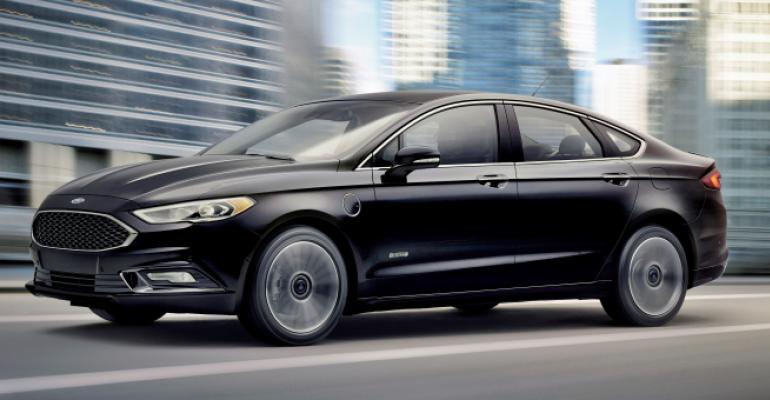Ford says improvements to its ’17 Fusion Energi sedan give it a combined range of 610 miles (982 km), the most of any plug-in hybrid vehicle.
The total range is up 60 miles (97 km), compared with the previous year’s model an 11% gain, including a 22% increase in electric-only miles to 22 (35 km), according to EPA estimates.
Ford says its nearest competitors in total range among PHEVs are the Hyundai Sonata PHEV at 600 miles (966 km), the Honda Accord PHEV at 570 miles (917 km) and the Porsche Panamera S PHEV at 560 miles (901 km). Ford’s non-plug-in Fusion Hybrid range is unchanged for the ’17 model year at 567 miles (912 km).
Ford says the Energi gained range through a series of improvements including use of lighter-weight engine oil, powertrain optimization, improved electric-motor efficiency, reduced brake drag and better aerodynamics.
Despite the diesel-like range offered by PHEVs, a recent Harris Poll shows most consumers are confused by the capabilities of various electrically powered vehicles on the market. They include fully battery-electric vehicles such as the Tesla Model S, hybrids such as the Toyota Prius and the PHEVs such as the Chevrolet Volt and Fusion Energi.
Those polled estimated plug-ins can travel 260 miles (418 km) – less than half the distance of the Energi on a full charge and full tank of fuel – and 76% of the 1,052 respondents couldn’t guess the maximum range of a PHEV.
“Fusion Energi – with a full battery and a full tank of gas – can go from San Diego, through Los Angeles and all the way up to San Francisco, and still have up to 110 miles (177 km) of range remaining,” says Wade Jackson, Fusion marketing manager. “Plug-in hybrids are electric vehicles until you run down the battery and then they work exactly like a conventional hybrid.”
Although Ford says it was the top seller of plug-ins in 2015 and is leading the segment this year with PHEV sales up 58%, consumer confusion and low fuel prices have dampened sales of electric vehicles in general, and not just for Ford.
“There’s a very limited understanding, even among people who are relatively sophisticated about vehicles, about what a plug-in hybrid really is,” says Chris Hosford, a spokesman for Hyundai Motor America.
“Time and again we see people say ‘I don’t want a plug-in hybrid, I don’t want to have to run my car on batteries all the time.’ They clearly miss the point.”
Hyundai executives believe that if they can explain PHEVs to people they will find the technology preferable to conventional hybrids. In fact, the Sonata PHEV is priced so salespeople can try to move Sonata hybrid intenders into the PHEV. Including government incentives, the Sonata PHEV actually is slightly less expensive than the HEV version, Hosford says.
“We want to shift people over to plug-in hybrids, because we think it will be a much more satisfying experience for them,” he says.
Ford hopes disseminating information about the Energi’s improved range will help clear up some of the confusion, but the company is learning that word-of-mouth vs. big advertising campaigns is the best way to reach prospective EV buyers.
“The shotgun approach just doesn’t work,” Ford spokesman Chris Terry says.
The next challenge is helping consumers understand the different types of hybrids so they can choose the right vehicle for their use. Urban commuters would be better served by a pure battery-electric vehicle or PHEV, while longer-distance drivers should opt for a traditional hybrid, Terry says.
“This is a challenge for the industry,” Terry says. “The product excellence is there.”
Ford sells six electrified vehicles and plans to invest $4.5 billion to add 13 more electrified vehicles by 2020 when more than 40% of its global portfolio will be electrified.
– with Drew Winter
[email protected] @bobgritzinger





